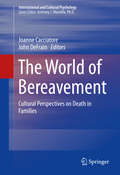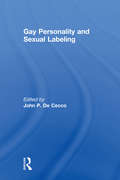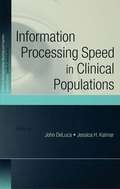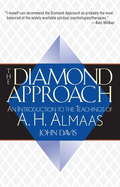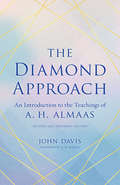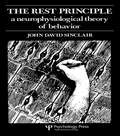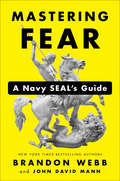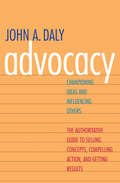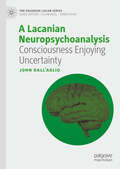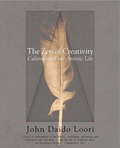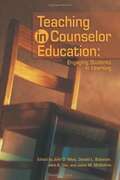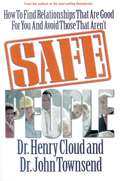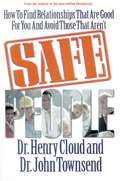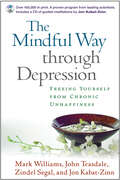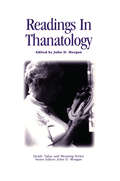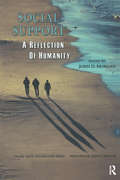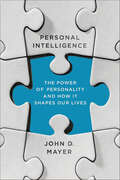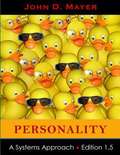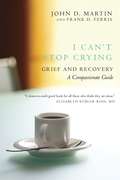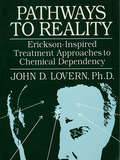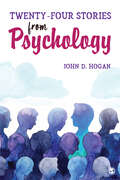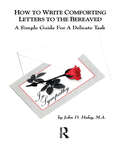- Table View
- List View
The World of Bereavement
by John Defrain Joanne CacciatoreThis visionary work explores the sensitive balance between the personal and private aspects of grief, the social and cultural variables that unite communities in bereavement, and the universal experience of loss. Its global journey takes readers into the processes of coping, ritual, and belief across established and emerging nations, indigenous cultures, and countries undergoing major upheavals, richly detailed by native scholars and practitioners. In these pages, culture itself is recognized as formed through many lenses, from the ancestral to the experiential. The human capacity to mourn, endure, and make meaning is examined in papers such as: Death, grief, and culture in Kenya: experiential strengths-based research. Death and grief in Korea: the continuum of life and death. To live with death: loss in Romanian culture. The Brazilian ways of living, dying, and grieving. Death and bereavement in Israel: Jewish, Muslim, and Christian perspectives. Completing the circle of life: death and grief among Native Americans. It is always normal to remember: death, grief, and culture in Australia. The World of Bereavement will fascinate and inspire clinicians, providers, and researchers in the field of death studies as well as privately-held professional training programs and the bereavement community in general.
Gay Personality And Sexual Labeling: Critical Clinical Issues
by John Dececco, PhdAre scientists--who by definition are supposed to be objective and clinical in their theories--actually assuming common cultural prejudices and moral standards when it comes to their research on homosexuality? Some of the best minds in sexual liberation take a hard look at how homosexuality is still defined and viewed by established schools of thought and propose fascinating and often controversial ideas on the true nature of the gay personality and identity. This challenging book explores how gay people can “label” themselves or avoid the gay label entirely while still being homosexual, as well as how others label gay people.
Information Processing Speed in Clinical Populations (Studies on Neuropsychology, Neurology and Cognition)
by John DeLuca Jessica H. KalmarAlthough investigated for over 100 years, it is only now that we are beginning to understand how speed of information processing is affected in various clinical populations. Processing speed has a major impact on higher level cognitive abilities and is extremely vulnerable to neurological insult and the aging process. The importance of processing speed with respect to brain function, cognition and overall quality of life is now the focus of a new and exciting body of research in clinical populations. This book provides a scholarly and clinically sensitive review of research on processing speed and its issues in clinical populations. Readers will come away with an in-depth understanding of human information processing speed including its historical development, its relationship to other cognitive functions, the developmental course of the ability across the lifespan, and its impact on everyday life in various clinical populations. Other highlights of the text are its discussion of the speed vs. accuracy trade-off, tools available for measuring processing speed, the unfolding research on genetic contributions to processing speed, and the latest ideas in rehabilitation. With contributing authors who are experts in their fields, Information Processing Speed in Clinical Populations represents a valuable resource for researchers, scholars, and clinicians by providing a concise summary of the existing research on processing speed across an array of disciplines and populations.
Tobacco Use and Intimate Relationships: Smokers And Non-smokers Tell Their Stories
by Ian Newman John DeFrainThis book presents a wide variety of insights into the effects of smoking on both smokers and non-smokers. Based on extensive questionnaire surveys from across the USA, this research explores the complex dynamics of intimate relationships and how they are affected by smoking, especially with regard to honest communication. The volume delves into the battles which take place behind closed doors as both smokers and non-smokers invoke personal rights and argue their positions. Finally, the authors explore how health policy and public policy can better serve both smokers and non-smokers, and what the future may hold for the regulation of tobacco use.
The Diamond Approach
by John Davis A. H. AlmaasThe Diamond Approach has been developed and taught over the last twenty-five years by Hameed Ali (known chiefly by his pen name, A. H. Almaas), who is widely recognized as a leader in the integration of spirituality and psychology. This is the first book to introduce the complete spectrum of his teachings to a general audience.
The Diamond Approach: An Introduction to the Teachings of A. H. Almaas
by John DavisA revised and expanded edition of the definitive guide to the Diamond Approach, the modern contemplative practice that integrates psychology and spirituality and emphasizes the importance of self-inquiry. The Diamond Approach has been developed and taught over the last forty-five years by Hameed Ali, who is known chiefly by his pen name, A. H. Almaas. This book, the first to offer a full overview of the Diamond Approach, is now revised and expanded with a new foreword by Almaas, a new preface by the author, and a new chapter that explores the most recent developments in Almaas's teaching and practice methods. Author John Davis offers a rich, compelling introduction to the unique spiritual tradition that philosopher Ken Wilber recommends as "the most balanced of the widely available spiritual psychologies/therapies." Influenced by ancient traditions such as Sufism and Buddhism as well as by modern psychology, the Diamond Approach is particularly well-suited to twenty-first century seekers who embrace both spirituality and science. Beginning with an account of his own work with the Diamond Approach, Davis proceeds to outline the tradition's central practice of Inquiry, a form of open-ended exploration of present-moment experience akin to mindfulness practice. From there, he launches readers into an exploration of metaphysical concepts such as soul, space, Essence, self-realization, and the dimensions of Being. Complex yet concise, profound yet accessible, The Diamond Approach offers readers bold new perspectives on reality and human potential.
The Rest Principle: A Neurophysiological Theory of Behavior
by J. D. Sinclair John David SinclairFirst published in 1982. Routledge is an imprint of Taylor & Francis, an informa company.
Mastering Fear: A Navy SEAL's Guide
by John David Mann Brandon WebbFrom New York Times bestselling author and former Navy SEAL Brandon Webb comes a simple yet powerful five-step guide to transforming your life by making your fears work for you instead of against you.Brandon Webb has run life-threatening missions in the world's worst trouble spots, whether that meant jumping out of airplanes, taking down hostile ships on the open sea, or rolling prisoners in the dead of night in the mountains of Afghanistan. As a Navy SEAL, he learned how to manage the natural impulse to panic in the face of terrifying situations. As media CEO and national television commentator, he has learned how to apply those same skills in civilian life. Drawing on his experiences in combat and business, along with colorful anecdotes from his vast network of super-achiever friends from astronauts to billionaires, Webb shows how people from all walks of life can stretch and transcend their boundaries and learn to use their fears as fuel to achieve more than they ever thought possible. "Fear can be a set of manacles, holding you prisoner," writes Webb. "Or it can be a slingshot, catapulting you on to greatness."The key, says Webb, is not to fight fear or try to beat it back, but to embrace and harness it. In the process, rather than being your adversary, your fear becomes a secret weapon that allows you to triumph in even the most adverse situations. In Mastering Fear, Webb and his bestselling coauthor John David Mann break this transformation down into five practical steps, creating a must-read manual for anyone looking for greater courage and mastery in their lives.
Advocacy
by John DalyWhen a group of people gather together to generate ideas for solving a problem or achieving a goal, sometimes the best ideas are passed over. Worse, a problematic suggestion with far less likelihood of success may be selected instead. Why would a group dismiss an option that would be more effective? Leadership and communications expert John Daly has a straightforward answer: it wasn't sold to them as well. If the best idea is yours, how can you increase the chances that it gains the support of the group? In Advocacy: Championing Ideas and Influencing Others, Daly explains in full detail how to transform ideas into practice. To be successful, leaders in every type of organization must find practical and action-oriented ways to market their ideas and achieve buy-in from the members of the group. Daly offers a comprehensive action guide that explains how to shape opinion, inspire action, and achieve results. Drawing on current research in the fields of persuasion, power relations, and behavior change, he discusses the complex factors involved in selling an idea--the context of the communication, the type of message being promoted, the nature and interests of the audience, the emotional tenor of the issues at stake, and much more. For the businessperson, politician, or any other member of a group who seeks the satisfaction of having his or her own idea take shape and become reality, this book is an essential guide.
A Lacanian Neuropsychoanalysis: Consciousness Enjoying Uncertainty (The Palgrave Lacan Series)
by John Dall’AglioThis book brings together Lacanian psychoanalysis, neuropsychoanalytic work by Mark Solms and Ariane Bazan, Jaak Panksepp’s affective neuroscience, Karl Friston’s free energy principle, Adrian Johnston’s transcendental materialist philosophy, and Darian Leader’s critique of jouissance in Lacanian theory. In doing so, it articulates a philosophical and scientific basis for Lacanian neuropsychoanalysis. A Lacanian perspective on Solms’s recent neuropsychoanalytic developments in affective consciousness and predictive coding furnishes an immanent critique that advances both Lacanian psychoanalysis and neuropsychoanalysis. Dall’Aglio develops novel propositions for conceptualizing the Lacanian real, symbolic, and imaginary registers in the brain, treating affect systems like signifiers, viewing jouissance as surplus prediction error, and conceiving the brain as structurally antagonistic. It presents fresh theoretical and clinical insights in a manner that will be accessible to the interdisciplinary fields it draws upon. It will appeal to those working in neuropsychoanalysis, clinical psychology, neuroscience, psychoanalysis, and critical theory.
The Zen of Creativity
by John Daido LooriFor many of us, the return of Zen conjures up images of rock gardens and gently flowing waterfalls. We think of mindfulness and meditation, immersion in a state of being where meaning is found through simplicity. Zen lore has been absorbed by Western practitioners and pop culture alike, yet there is a specific area of this ancient tradition that hasn't been fully explored in the West. Now, in The Zen of Creativity, American Zen master John Daido Loori presents a book that taps the principles of the Zen arts and aesthetic as a means to unlock creativity and find freedom in the various dimensions of our existence. Loori dissolves the barriers between art and spirituality, opening up the possibility of meeting life with spontaneity, grace, and peace.Zen Buddhism is steeped in the arts. In spiritual ways, calligraphy, poetry, painting, the tea ceremony, and flower arranging can point us toward our essential, boundless nature. Brilliantly interpreting the teachings of the artless arts, Loori illuminates various elements that awaken our creativity, among them still point, the center of each moment that focuses on the tranquility within; simplicity, in which the creative process is uncluttered and unlimited, like a cloudless sky; spontaneity, a way to navigate through life without preconceptions, with a freshness in which everything becomes new; mystery, a sense of trust in the unknown; creative feedback, the systematic use of an audience to receive noncritical input about our art; art koans, exercises based on paradoxical questions that can be resolved only through artistic expression. Loori shows how these elements interpenetrate and function not only in art, but in all our endeavors.Beautifully illustrated and punctuated with poems and reflections from Loori's own spiritual journey, The Zen of Creativity presents a multilayered, bottomless source of insight into our creativity. Appealing equally to spiritual seekers, artists, and veteran Buddhist practitioners, this book is perfect for those wishing to discover new means of self-awareness and expression--and to restore equanimity and freedom amid the vicissitudes of our lives.From the Hardcover edition.
Teaching in Counselor Education: Engaging Students in Learning
by Don Bubenzer John D. West Jane A. Cox Jason M. McGlothlinTeaching and actively engaging students in learning is a continuous pursuit for counselor educators. We now have the first book in the profession that provides help for this ongoing endeavor. <p><p>Teaching in Counselor Education: Engaging Students in Learning presents thought-provoking ideas for doctoral students in counselor education and also for beginning and experienced counselor educators who wish to continue reflecting on and improving their teaching skills. <p><p> The chapters, written by experienced and highly regarded counselor educators, discuss a variety of teaching practices with practical suggestions for application, describe the authors' personal experiences, and give illustrative case examples. Topics covered include establishing effective student-teacher relationships, using solution-focused evaluations in teaching, delivering lectures, employing experiential learning, utilizing out-of-class learning, implementing distance learning, conducting seminars, making use of technology in teaching, and much more. This book is a valuable tool for readers to consider new perspectives on teaching and learning.
Personas Seguras: Como encontrar relaciones que le sean provechosas y evadir las que no lo son
by John D. Townsend Henry CloudPersonas Seguras le ayudará a reconsiderar su forma de iniciar relaciones. Basta ya de fracasos. Comience a disfrutar las relaciones saludables y balanceadas que todos queremos y necesitamos. <P><P> ¿HA ENTREGADO ALGUNA VEZ LO MEJORY H RECIBIDO A CAMBIO LO PEOR?Las heridas producidas por personas > pueden ser penetrantes. Si ha tenido relaciones que se han aprovechado de usted, si han abusado de usted o lo han abandonado, tiene que leer Personas Seguras. Lo ayudará a tomar decisiones sabias lo mismo en cuanto a amistades que a romances. Descubrirá que las personas buenas pueden enredarse con personas malas. Y aprenderá cómo no volver a repetir los errores anteriores y cómo no volver a repetir los errores anteriores y cómo escoger personas seguras y saludables para establecer amistad o estar acompañado. Los doctores Cloud Townsend presentan opiniones expertas que lo ayudarán a: <br>• Corregir cosas en usted que pueden poner en peligro la seguridad de sus relaciones. <br>• Conocer los veinte rasgos de las personas que no son dignas de confianza <br>• Reconocer qué hace digna de confianza a una persona <br>• Evitar las relaciones enfermizas <br>• Establecer relaciones positivas <br>• Ser usted una persona segura <P>Personas Seguras le ayudará a reconsiderar su forma de iniciar relaciones. Basta ya de fracasos. Comience a disfrutar las relaciones saludables y balanceadas que todos queremos y necesitamos.
Safe People: How to Find Relationships That Are Good for You and Avoid Those That Aren't
by John D. Townsend Henry CloudFinding safe people provides the foundation for building healthy, lasting relationships. Here's how to identify safe people.
Mindful Way through Depression (Enhanced)
by John D. Teasdale J. Mark WilliamsIf you've ever struggled with depression, take heart. Mindfulness, a simple yet powerful way of paying attention to your most difficult emotions and life experiences, can help you break the cycle of chronic unhappiness once and for all. In The Mindful Way through Depression, four uniquely qualified experts explain why our usual attempts to "think" our way out of a bad mood or just "snap out of it" lead us deeper into the downward spiral. Through insightful lessons drawn from both Eastern meditative traditions and cognitive therapy, they demonstrate how to sidestep the mental habits that lead to despair, including rumination and self-blame, so you can face life's challenges with greater resilience. This e-book includes an audio program of guided meditations, narrated by Jon Kabat-Zinn, for purchasers to stream or download from the Web.
Readings in Thanatology (Death, Value and Meaning Series)
by John D. MorganA comprehensive book of readings for courses on death and dying at the college or university level. It contains material by such leaders in the field as: Colin Murray Parkes, MD, John Hinton, MD, Kenneth Doka, PhD, Ira R Byock, MD, Ronald K Barrett, PhD, Robert G Stevenson, EdD, Judith M Stillion, PhD.
Social Support: A Reflection of Humanity (Death, Value and Meaning Series)
by John D. MorganNone of us could survive in the workplace, community, or even in our homes, if we allowed everyone to see how truly vulnerable we are. Yet, social support is a necessity if we are to achieve whatever it is we set out to achieve in this life. "No human being is an island unto himself." "Social Support: A Reflection of Humanity" is a "how to" book. In this work, the authors examine the nature of social support, how it can be offered, and how social support differs from other forms of therapy.
Personal Intelligence: The Power of Personality and How It Shapes Our Lives
by John D. MayerJohn D. Mayer, the renowned psychologist who co-developed the groundbreaking theory of emotional intelligence, now draws on decades of cognitive psychology research to introduce another paradigm-shifting idea: that in order to become our best selves, we use an even broader intelligence—which he calls personal intelligence—to understand our own personality and the personalities of the people around us. In Personal Intelligence, Mayer explains that we are naturally curious about the motivations and inner worlds of the people we interact with every day. Some of us are talented at perceiving what makes our friends, family, and coworkers tick. Some of us are less so. Mayer reveals why, and shows how the most gifted "readers" among us have developed "high personal intelligence." Mayer's theory of personal intelligence brings together a diverse set of findings—previously regarded as unrelated—that show how much variety there is in our ability to read other people's faces; to accurately weigh the choices we are presented with in relationships, work, and family life; and to judge whether our personal life goals conflict or go together well. He persuasively argues that our capacity to problem-solve in these varied areas forms a unitary skill. Illustrating his points with examples drawn from the lives of successful college athletes, police detectives, and musicians, Mayer shows how people who are high in personal intelligence (open to their inner experiences, inquisitive about people, and willing to change themselves) are able to anticipate their own desires and actions, predict the behavior of others, and—using such knowledge—motivate themselves over the long term and make better life decisions. And in outlining the many ways we can benefit from nurturing these skills, Mayer puts forward an essential message about selfhood, sociability, and contentment. Personal Intelligence is an indispensable book for anyone who wants to better comprehend how we make sense of our world.
Personality: A Systems Approach
by John D. MayerA book, whose main goal is to provide the very best information on personality psychology as it employs new scientific framework to focus on an integrated picture of personality.
I Can't Stop Crying: Grief and Recovery, A Compassionate Guide
by John D. Martin Frank D. FerrisFor anyone who has experienced a significant loss, this wonderfully informative and accessible book is a guide to understanding and overcoming grief.The death of someone close -- a familiy member, spouse, or partner -- can result in feelings of overwhelming grief. At the same time, society unrealistically expects people to recover from grief as quickly as possible. I Can't Stop Crying looks at grieving as a painful but necessary process. The authors emphasize the importance of giving permission to grieve and suggest steps for rebuiliding life without the one who is gone. They also look at how such a loss affects relationships with family and friends, as well as lifestyle, work habits, and hopes for the future. The book includes an appendix with bereavement groups, resources, and other self-help organizations for grievers.From the Trade Paperback edition.
Pathways To Reality: Erickson-Inspired Treatment Aproaches To Chemical dependency
by John D. LovernConsiders the use of Erickson-inspired therapeutic techniques in the treatment of chemical dependency. It also provides an overview of Erickson-Inspired Approaches To Treatment, Including Motivation, utilization, confusion, trance, the indirect approach and ordeals.
Twenty-Four Stories From Psychology
by John D. HoganA good story sets the stage for engaged learning. Nowhere is this more important than in foundational courses, such as Introductory or History of Psychology. By weaving foundational and modern characters across a historical landscape, John Hogan’s Twenty-Four Stories from Psychology captivates readers with the rich stories- the who, what, where, why and how- for many of the major theories and colorful characters who have shaped the development of Psychology as a field.
Twenty-Four Stories From Psychology
by John D. HoganA good story sets the stage for engaged learning. Nowhere is this more important than in foundational courses, such as Introductory or History of Psychology. By weaving foundational and modern characters across a historical landscape, John Hogan’s Twenty-Four Stories from Psychology captivates readers with the rich stories- the who, what, where, why and how- for many of the major theories and colorful characters who have shaped the development of Psychology as a field.
How to Write Comforting Letters to the Bereaved: A Simple Guide for a Delicate Task
by John D. Haley"How to Write Comforting Letters to the Bereaved" guides readers through the delicate task of penning their thoughts and emotions to friends or family members suffering the loss of a loved one. It lays out an array of suggestions, precautions and examples in a clear and informed style. This friendly, easy-to-read guide enables professional caregivers and lay readers alike to quickly take what they need from a number of considerations, such as: how to start such a letter; how to elaborate on the relationship, the loss, and its meaning to the reader; various ways to help survivors regardless of geographic distance; important precautions about what to avoid; different approaches to talking about religious faith; the inclusion of humor; plus follow-up letters long after the funeral; and more.
A Conceptual History of Psychology: Exploring the Tangled Web
by John D. GreenwoodIn the new edition of this original and penetrating book, John D. Greenwood provides an in-depth analysis of the subtle conceptual continuities and discontinuities that inform the history of psychology from the speculations of the Ancient Greeks to contemporary cognitive psychology. He also demonstrates the fashion in which different conceptions of human and animal psychology and behavior have become associated and disassociated over the centuries. Moving easily among psychology, history of science, physiology, and philosophy, Greenwood provides a critically challenging account of the development of psychology as a science. He relates the remarkable stories of the intellectual pioneers of modern psychology, while exploring the social and political milieu in which they operated, and dispels many of the myths of the history of psychology, based upon the best historical scholarship of recent decades. This is an impressive overview that will appeal to scholars and graduate students of the history of psychology.
